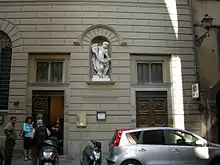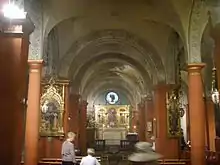St Mark's English Church, Florence
Saint Mark's English Church is an Anglican church in Florence, Italy.

The church forms part of the chaplaincy[lower-alpha 1] of St Mark's Florence with St Peter's Siena, which also includes a congregation in Bologna, in the Diocese in Europe of the Church of England.[1]
The chaplain is Father William Lister.[2] The average congregation is about 150. The church ministers to the homeless in Florence. It is also used for classical music concerts and opera, with a resident opera company.[3]
History
St Mark's was founded by the Reverend Charles Tooth as a centre of worship for Anglo-Catholic members of the Anglican Church in Florence. He started a house church at 1 Via dei Serragli in 1877 to teach Anglo-Catholic principles and celebrate the Holy Eucharist daily during the week. In 1880,[4] Tooth purchased a 15th-century palazzo to meet the new congregation's needs. John Roddam Spencer Stanhope designed and created the wall and ceiling decorations at his own expense.[5] The first Holy Eucharist was celebrated there on 1 May 1881, although chaplain and church were not licensed for service by the bishop until 1884.[6] The premises were extended by the purchase of 16 Via Maggio in 1906.[7]
The church was damaged by the 1966 Flood of the Arno River, resulting in the loss of George Frederick Bodley's 19th-century stencil work on the lower walls, although some survived behind a display cabinet.[8]
St. Mark's was the second Anglican church to be built in Florence. The British community in Florence has a long history[9] and the chaplaincy began in the late 1820s. The first church, Holy Trinity, opened in the 1840s. Rebuilt in the 1890s, Trinity Church on the Via Lamarmara, is today a Waldensian Church.
Architecture

Exterior
The white marble statue in the niche over the main door is Apotheosis of Saint Mark (2007–8) by Jason Arkles.[10] This is the first work by an American sculptor to have a permanent public location in Florence.[11]
Interior
The building was altered by Tooth, who turned the ground floor into a church with nave, aisles, transept and chancel, about 90 feet (27 m) long[4] and seating 400.[3] The interior is decorated in the Pre-Raphaelite style and the upper reaches of the church have floral motifs with, as described by art historian Berenice Schreiner, "a wonderful sense of naturalism".[4]
Notes
- A chaplaincy in this context is rather like a parish but with a more fluid membership. In this case it mainly serves three groups of English speakers: expatriates, students and tourists in Tuscany and Emilia-Romagna, with participants often travelling long distances.[lower-alpha 2]
References
- "Chaplaincy". Florence: St Mark's English Church. Retrieved 4 January 2014.
- "Staff and Ministry". Florence: St Mark's English Church. Retrieved 4 January 2014.
- Brucato, Haley (11 April 2013). "More than Meets the Eye". The Florentine (181). Retrieved 1 July 2013.
- Schreiner 2001, p. 90.
- Schreiner 2001, p. 90: quoting Varty, H. A. (1934). A Short History of St Mark's English Church. Unpublished. p. 15.
- Mittler 2011, p. 49.
- "History". Florence: St Mark's English Church. Archived from the original on 12 July 2011. Retrieved 21 June 2013.
- Schreiner 2001, pp. 90–91.
- Mittler 2007.
- "Apotheosis Of Saint Mark". Monuments. Jason Arkles. Retrieved 30 June 2013.
- "Modern Art in Florence". LdM News. Florence: Lorenzo de' Medici School. Retrieved 3 July 2013.
Citations
- Mittler, Penny (2007). "The Church of England Chaplaincies in Florence since 1820" (PDF). Florence: St Mark's English Church. Retrieved 20 January 2014.CS1 maint: ref=harv (link)
- Mittler, Penny (2011) [first published 2007]. "Only Connect: A Case Study of the Influence of the English Church and the Non-Catholic Cults in the Florence of the Risorgimento". In Faltin, L.; Wright, M. (eds.). The Religious Roots of Contemporary European Identity. London: Continuum Press. pp. 40–52. ISBN 978-1-4411-9571-5.CS1 maint: ref=harv (link)
- Schreiner, Berenice (Spring 2001). "The Collaboration of G. F. Bodley & J. R. Spencer Stanhope in Florence 1892–1904" (PDF). Journal of William Morris Studies. 14 (2): 90–95. ISSN 0084-0254.CS1 maint: ref=harv (link)
External links
| Wikimedia Commons has media related to Saint Mark (Florence). |
- Official website
- Previous website at the Wayback Machine (archived 14 January 2012)